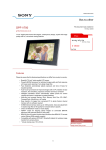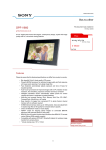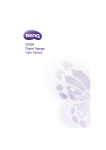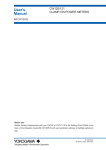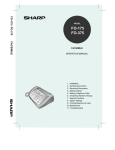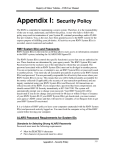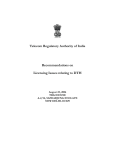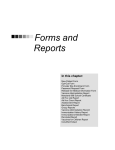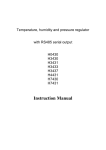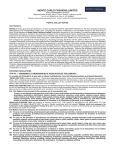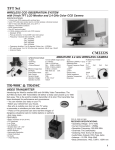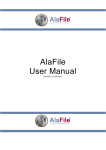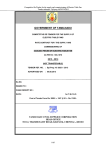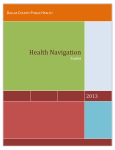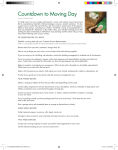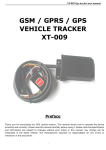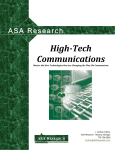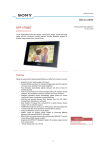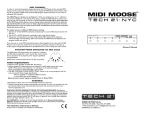Download BSCC Response to Public Comment
Transcript
BACKGROUND SCREENING AGENCY ACCREDITATION PROGRAM Standard with Audit Criteria, Public Comment and BSCC Response Clause Measure & Documentation Typically Subject to Desk Audit Data Information and Security 1.1 Information Security CRA shall have a written information security policy. CRA shall CRA shall provide written information security policy. designate one or more individuals within the organization who are responsible for implementing, managing and enforcing the information security policy. 1.2 Data Security CRA shall have procedures in place to protect consumer information under the control of the CRA from internal and external unauthorized access. These procedures shall include specifications for the securing of information in both hard copy and electronic form, including information stored on portable and/or removable electronic devices. 1.3 Intrusion and Data Security CRA shall have procedures in place to detect, investigate and respond to an information system intrusion, including consumer notification where warranted. 1.4 Stored Data Security CRA shall have procedures in place to ensure backup data is stored in an encrypted or otherwise protected manner. 1.5 Password Protocol CRA shall require strong password protocol pursuant to current security best practices. Attributes of and Suggestions for Onsite Audit What auditor should look for in policy, procedure, activity Potential Verification for Onsite Audit Public Comment Period Feedback CRA shall present written information security policy. If questioned, CRA employees should demonstrate knowledge of information security policy and be able to access current policy. This is an overarching information security policy which broadly addresses security within the CRA environment. This policy may reference other security policies and/or procedures dealing with specific security topics. The security topics addressed may include some or all of the following, but are not limited to: confidentiality agreements with vendors and employees; physical security of consumer information; electronic security of consumer information; communicating consumer information to vendors, clients, and other parties; providing and communicating information to consumers; permissible uses of portable and/or removeable electronic storage devices. CRA shall employ or retain a minimum of one person who is CRA shall present written job description, policy, procedure or other responsible for CRA's overall information security program. This will documentation which identifies, by name and/or title, the person be evidenced by written job description, policy, procedure, or other responsible for the overall information security program. documentation. If various people are responsible for different aspects of the program, one person shall hold overall responsibility as evidenced by job description, organizational chart, or other documentation. CRA shall make available documentation which clearly identifies person, by name and title, who is responsible for overall information security program. CRA shall provide written procedures in place to protect consumer information from unauthorized electronic and/or physical access. This includes the collection, use, storage, and destruction of consumer information in both paper and electronic form. CRA employees dealing with consumer information shall be able to explain and demonstrate procedures for protecting consumer information in their posession, whether such information is used internally and/or externally, and be able to access current documentation. CRA will also be able to demonstrate electronic and physical protection of consumer information. The policies and procedures designed to protect consumer information may 1.2 - does not make clear that “hard copy” documents with consumer information must be protected only if include some or all of the following, but are not limited to: 1) securing they are in the CRA’s custody. Any entity mailing or faxing consumer reports would be responsible for unattended workstations, 2) limited access to networks, data, and work areas, documents not even in its possession under this standard. 3) limiting consumer information provided to information sources to only that information which is needed to conduct a search, 4) destruction of hard copy documents, 5) identification of caller before providing consumer information, 6) employee badging or other identification system, 7) unescorted visitor policy, 8) secure document destruction, 9) secure transport of information, 10) use of encryption and/or secure networks and/or websites, 11) password assignment and replacement, 12) controlling use of portable storage devices, 13) alarm systems, 14) door locks, and 15) secure server and back-up sites. CRA shall provide procedures for detecting and identifying information system intrusions (unauthorized access to computer systems and/or consumer data). CRA shall provide procedures for responding to information system intrusions including how consumer notification requirements are determined. CRA shall make available the procedure, process, and/or tools used to monitor access and identify potential intrusions. CRA should be able to present proof of tools used to protect network, data, and consumer information. This may be intrusion/detection testing results, firewall protections used, secure website, etc. Process/procedure should include some or all of, but is not limited to: 1) individual to contact in case of intrusion and his/her back-ups, 2) necessity of immediately stopping intrusion activity, if still occurring, 3) determination of notification requirements, 4) preparing notification, 5) obtaining necessary approvals of notification language, 6) communicating notification, and 7) debrief to prevent future occurrences. CRA shall make available the procedure, process, and/or tools used to respond to intrusions. If questioned, CRA employees should demonstrate knowledge of procedure to be followed in case of intrusion or suspected intrusion and be able to access current documentation. CRA shall provide written policy, procedure or other documentation CRA shall make available the individual responsible for data backup explaining data backup, storage, and access procedures. and storage. This individual shall be able to describe and/or provide documentation related to backup and data storage. The process used to backup and store data should include: limiting backup to select authorized individuals, secure transport of backup tapes to storage facility, and security at the storage location. At a minimum this includes locked storage facility and password protected access. CRA shall provide written policy, procedure, or other documentation CRA shall make available the individual responsible for password which explains password protocol and how such protocol is used. protocol. This individual shall be able to describe and/or provide documentation related to password characteristics, assignment, replacement, and recordkeeping. If questioned, CRA employees who use passwords shall explain process to obtain a password for him/herself and/or client and be able to access current documentation. CRA should demonstrate that password is required for sign-on and also demonstrate procedure for changing password. Required password should be a minimum of six (6) characters, preferably using both alpha and numeric characters. Records of password issuance should be securely maintained. A biometric solution would also be acceptable. 1.6 Electronic Access Control CRA shall have procedures in place to control access to all CRA shall provide written policy, procedure or other documentation electronic information systems and electronic media that contain explaining how access rights to consumer information are consumer information. CRA shall have procedures in place to controlled, administered, and limited. administer access rights. Users shall only be given the access necessary to perform their required functions. Access rights shall be updated based on personnel or system changes. BSCC Response DEFINITION: Consumer information includes any information identifiable to one or more consumers, including that found in vendor reports, CRA shall make available the individual responsible for controlling access to consumer information. This individual shall be able to describe and/or provide documentation and/or provide a demonstration related to access control. If questioned, CRA employees who receive such requests will demonstrate knowledge of process if change in access rights is to be requested. Process should include some or all of, but is not limited to: 1) how users apply for and receive access, 2) authorization needed for access, 3) access parameters, 4) password issuance/replacement/expiration, 5) monitoring tools, and 6) recordkeeping. Based on further consideration, beta test feedback and/or legal review, the BSCC has removed "qualified" from the Clause as well as corresponding desk and onsite audit criteria.. The BSCC has inserted "under the control of the CRA" into the Clause to clarify that this clause is addressing information under the control of the CRA. Data transmission security is covered in other areas of the Standard. Based on further consideration, beta test feedback and/or legal review, the BSCC has removed "effectively" from the Clause. 1.7 Physical Security FEBRUARY 16, 2009 NAPBS - CRA ACCREDITATION STANDARD WITH AUDIT CRITERIA PAGE 1 OF 11 BACKGROUND SCREENING AGENCY ACCREDITATION PROGRAM Standard with Audit Criteria, Public Comment and BSCC Response Clause Measure & Documentation Typically Subject to Desk Audit Attributes of and Suggestions for Onsite Audit What auditor should look for in policy, procedure, activity Potential Verification for Onsite Audit CRA shall have procedures in place to control physical access to CRA shall provide written policy, procedure or other documentation CRA shall provide auditor a tour of the facility, demonstrating and all areas of CRA facilities that contain consumer information. explaining how access to areas of CRA facilities containing describing the physical security measures in place. Auditor may consumer information is controlled. interview CRA staff about physical security procedures. 1.8 Consumer Information Privacy Policy CRA shall have a Consumer Information Privacy Policy detailing the purpose of the collection of consumer information, the intended use, and how the information will be shared, stored and destroyed. The CRA shall post this policy on its Web site, if it has one, and will make said policy available to clients and/or consumers upon request in at least one other format. 1.9 Unauthorized Browsing CRA shall have a policy that prohibits workers from searching files and databases unless they have a bona fide business necessity. 1.12 Sensitive Data Masking CRA shall have a procedure to suppress or truncate Social Security numbers and other sensitive data elements as required by law. 1.13 Database Criminal Records When reporting potentially adverse criminal record information derived from a non-government owned or non-government sponsored/supported database pursuant to the federal FCRA, the CRA shall either: A) verify the information directly with the venue that maintains the official record for that jurisdiction prior to reporting the adverse information to the client; or B) send notice to the consumer at the time information is reported. BSCC Response Based on further consideration, beta test feedback and/or legal review, the BSCC has added "of CRA facilities" to the Clause. CRA shall provide a copy of the Consumer Information Privacy CRA employees shall be able to access current copy of Privacy Policy Policy along with the address of the policy on the CRA's website (if and describe process by which privacy policy may be communicated CRA has website) and an explanation of other means by which externally. privacy policy is communicated. The policy should include some or all of, but is not limited to, the following: the purpose of the collection of consumer information, the intended use, and how the information will be shared, stored and destroyed. The CRA shall post this policy on its website, if it has one, and will make said policy available to clients and/or consumers upon request utilizing at least one other method. CRA shall provide written policy, procedure, or other document (employee handbook, etc.) which instructs CRA employees on appropriate and/or inappropriate use of consumer information. CRA employees with access to consumer information shall demonstrate knowledge of proper use of consumer information and be able to access current copy of documentation. Documentation should include statement of appropriate use as being limited to business purposes only and include prohibition of browsing CRA employees shall demonstrate knowledge and use of proper document destruction procedures and be able to access current documentation. Documentation should require all consumer and client information be disposed of securely as to render information inaccessible, unreadable, and/or unrecoverable per current FTC rules in which the following methods are permitted: 1) burning, pulverizing, or shredding, 2) destroy or erase electronic files, and/or 3) after conducting due diligence, hire a document destruction company. In addition, paper documents containing personally identifiable information (particularly name, date of birth, and SSN) , if retained at individual desks/workstations, shall be destroyed or inaccessible no later than the end of each work day. Based on further consideration, beta test feedback and/or legal review, the BSCC changed the Clause to read "FTC regulations" as opposed to "FTC guidelines" CRA shall provide written policy, procedure, or other documentation CRA employees responsible for consumer disputes shall demonstrate which instructs CRA employees on consumer dispute procedures. knowledge of proper consumer dispute procedures and be able to access current copy of documentation. Auditor may request to see a (redacted) copy of dispute documentation. The policies and procedures designed to handle consumer disputes must meet FCRA requirements which include, but are not limited to: 1) no charge to consumer; 2) re-investigate, correct, and/or delete disputed information within 30 days (or 45 days if extended) of notice of dispute; 3) notify information provider of dispute within 5 days of receipt; 4) consider information provided by consumer, 5) advise consumer if dispute is deemed frivolous or irrelevant 6) notify appropriate parties of dispute results, and 7) comply with consumer request for description of re-investigation process. In addition, CRA should document: 1) responsibility of CRA employee receiving consumer dispute, 2) how incoming consumer dispute letters/emails/phone calls should be routed upon receipt, 3) re-investigation responsibility and/or procedures, 4) process for updating/correcting consumer report, 5) recordkeeping, and 6) procedure to help prevent future occurrences (such as recommendation for training, software change, etc.) Based on further consideration, beta test feedback and/or legal review, the BSCC has changed the Clause to read "that comply with" as opposed to "as required by" CRA shall provide written policy, procedure, or other documentation describing suppression, truncation, or other methods used to protect and limit exposure of SSN's and other sensitive data elements as required by law. Documentation should include but is not limited to: 1) No more than the final four digits of SSN's shall be communicated in any form outside CRA employees unless an approved exception exists, 2) When use of SSN and other sensitive data elements as required by law is needed internally or externally, the data exposed shall be limited to only that which is needed for the specific business purpose which has been identified, 3) When communicating SSN's or other data elements as required by law outside the CRA environment, secure transport methods shall be used. 1.12 dictating the masking of sensitive data does not reflect which data elements are sensitive. The state definitions of personal information should be emulated at this point as there is no federal breach law yet. Moreover, “industry standard” is a nebulous concept and referencing it in what is supposed to state the “industry standard” creates unnecessary ambiguity. The policy/procedure should include either: 1) process for verification of database information by researching in the originating jurisdiction/venue, or 2) process to inform applicant of potentially adverse information being reported to employer/prospective employer. 1.13 - regarding CRAs’ FCRA compliance when reporting public record data should use the exact language The BSCC has changed "B)" in the Clause to "Send notice to the consumer at the of section 613 of the FCRA. Section 613 does not use the word “contemporaneous.” It uses the phrase “at time information is reported." This was also changed in the Desk Audit section. This the time.” Moreover, by using “contemporaneous” as an adjective instead of an adverb in both the Standard change was made to make Clause consistent with the language of the FCRA. and the Measures, the organization could be deemed to be taking a position as to the manner of delivery of the notice that is inconsistent with current FTC guidance. The FTC opined in 1990, when reports were already and had for some time been being delivered to clients electronically, that the consumer notice requirements of section 613 could be met by use of first class mail. Such system clearly does not contemplate that compliance with 613 requires that notice be accomplished at the time the report is delivered, rather it contemplates that notice will be sent promptly to the consumer. 1.10 Record Destruction When records are to be destroyed or disposed of, CRA shall CRA shall provide written policy, procedure, or other document follow FTC regulations and take measures to ensure that all such (employee handbook, etc.) which instructs CRA employees on records and data are destroyed and unrecoverable. appropriate document destruction procedures. 1.11 Consumer Disputes CRA shall have procedures in place for handling and documenting a consumer dispute that comply with the federal FCRA. Public Comment Period Feedback Process/procedure should include some or all of, but is not limited to, the following: 1) procedures for granting levels of access to CRA personnel (e.g., assignment of keys or security system passcodes), 2) procedures for authorizing and monitoring guests (including the auditor) to the facility, and 3) control of access by staff, contingent workers, vendors, etc. CRA employees shall demonstrate knowledge of proper procedures for use of SSN's and other sensitive data elements as required by law and CRA employees shall be able to access current documentation. If interviewed, CRA employees shall demonstrate understanding of proper use and protection of SSN's and other sensitive data elements as required by law AND if applicable, the use of technology to protect SSN's and other sensitive data elements as required by law. CRA shall provide written policy, procedure, or other documentation CRA employees responsible for the use of non-governmental criminal describing method/s used to comply with current FCRA record databases shall demonstrate knowledge of compliant requirements of source verification or sending notice to the database reporting and be able to access current documentation. consumer at the time information is reported. The BSCC has deleted "and industry practice" from the Clause. The definition of what is considered "sensitive" varies by state law and is subject to change. The CRA is expected to be familiar with and comply with all laws in this area. Legal and Compliance 2.1 Designated Compliance Person(s) FEBRUARY 16, 2009 NAPBS - CRA ACCREDITATION STANDARD WITH AUDIT CRITERIA PAGE 2 OF 11 BACKGROUND SCREENING AGENCY ACCREDITATION PROGRAM Standard with Audit Criteria, Public Comment and BSCC Response Clause The CRA shall designate an individual(s) or position(s) within the organization responsible for CRA's compliance with all sections of the federal FCRA that pertain to the consumer reports provided by the CRA for employment purposes. 2.2 State Consumer Reporting Laws The CRA shall designate an individual(s) or position(s) within the organization responsible for compliance with all state consumer reporting laws that pertain to the consumer reports provided by the CRA for employment purposes. 2.3 Driver Privacy Protection Act (DPPA) The CRA shall designate an individual(s) or position(s) within the organization responsible for compliance with the DPPA that pertain to the consumer reports provided by the CRA for employment purposes, if the CRA furnishes consumer reports that contain information subject to the DPPA. 2.4 State Implemented DPPA Compliance If the CRA furnishes consumer reports that contain information subject to the DPPA-implementing statutes in a particular state(s), the CRA shall designate an individual(s) or position(s) within the organization responsible for compliance with state implementations of the DPPA that pertain to the products and services provided by the CRA for employment purposes. Measure & Documentation Typically Subject to Desk Audit 2.7 Agreement from Client FEBRUARY 16, 2009 Public Comment Period Feedback CRA shall employ a minimum of one person who is responsible for CRA's development, implementation, and on-going compliance with all applicable sections of the FCRA as evidenced by written job description/s or other documentation. If multiple people are responsible, one person shall hold CRA Leadership role and overall responsibility as evidenced by written job description or other documentation. CRA shall present written job description, policy, procedure or other documentation which identifies, by name and/or title, the person responsible for FCRA compliance. CRA shall make this person available either in person, by phone OR shall provide a signed affadavit or similar document in which the person has affirmed their responsibility for FCRA compliance within the organization. If interviewed, CRA employees shall identify the person/s who can provide FCRA expertise when needed. Compliance CRA Leader shall affirm his/her role as being responsible for FCRA compliance within the organization. 2.1 - reference “qualified individuals.” This term is not sufficiently defined by the Standard. Does it mean a lawyer is required since it is in reference to understanding the law? The Measures for this section do not appear to give guidance on what would constitute someone as “qualified” for these compliance roles. CRA shall employ a minimum of one person who is responsible for CRA's development, implementation, and on-going compliance with all applicable state consumer reporting law as evidenced by written job description/s or other documentation. If multiple people are responsible, one person shall hold CRA Leadership role and overall responsibility as evidenced by written job description or other documentation. CRA shall present written job description, policy, procedure or other Compliance CRA Leader shall affirm his/her role as being responsible for documentation which identifies, by name and/or title, the person state consumer reporting law compliance within the organization. responsible for state consumer reporting law compliance. CRA shall make this person available either in person, by phone OR shall provide a signed affadavit or similar document in which the person has affirmed their responsibility for state consumer reporting law compliance within the organization. If interviewed, CRA employees shall identify the person/s who can provide state consumer reporting law expertise when needed 2.2 - reference “qualified individuals.” This term is not sufficiently defined by the Standard. Does it mean a lawyer is required since it is in reference to understanding the law? The Measures for this section do not appear to give guidance on what would constitute someone as “qualified” for these compliance roles. CRA shall employ a minimum of one person who is responsible for CRA's development, implementation, and on-going compliance with all applicable DPPA law as evidenced by written job description/s or other documentation. If multiple people are responsible, one person shall hold CRA Leadership role and overall responsibility as evidenced by written job description or other documentation. CRA shall present written job description, policy, procedure or other documentation which identifies, by name and/or title, the person responsible for DPPA compliance. CRA shall make this person available either in person, by phone OR shall provide a signed affadavit or similar document in which the person has affirmed their responsibility for DPPA law compliance within the organization. If interviewed, CRA employees shall identify the person/s who can provide DPPA expertise when needed. 2.3 - reference “qualified individuals.” This term is not sufficiently defined by the Standard. Does it mean a lawyer is required since it is in reference to understanding the law? The Measures for this section do not appear to give guidance on what would constitute someone as “qualified” for these compliance roles. CRA shall employ a minimum of one person who is responsible for CRA's development, implementation, and on-going compliance with all applicable state DPPA laws as evidenced by written job description/s or other documentation. If multiple people are responsible, one person shall hold CRA Leadership role and overall responsibility as evidenced by written job description or other documentation. CRA shall present written job description, policy, procedure or other Compliance CRA Leader shall affirm his/her role as being responsible for documentation which identifies, by name and/or title, the person state DPPA law compliance within the organization. responsible for state DPPA law compliance. CRA shall make this person available either in person, by phone OR shall provide a signed affadavit or similar document in which the person has affirmed their responsibility for state DPPA law compliance within the organization. If interviewed, CRA employees shall identify the person/s who can provide state DPPA expertise when needed. 2.5 Integrity CRA shall not engage in bribery or any other fraudulent activity to CRA shall provide written policy, procedure, or other written obtain preferential treatment from a public official. documentation (such as an employee handbook) clearly forbidding bribery or any other fraudulent activity to obtain preferential treatment from a public official. 2.6 Prescribed Notices CRA shall provide client all federal FCRA-required, FTCprescribed documents which the federal FCRA mandates be provided to client by the CRA. Attributes of and Suggestions for Onsite Audit What auditor should look for in policy, procedure, activity Potential Verification for Onsite Audit CRA shall provide written policy, procedure, or other written documentation describing when/how clients are provided with copies of required FTC publications. Compliance CRA Leader shall affirm his/her role as being responsible for DPPA compliance within the organization. BSCC Response The BSCC has changed the Clause to read, "The CRA shall designate an individual(s) or position(s) within the organization responsible for CRA's compliance with all sections of the federal FCRA that pertain to the consumer reports provided by the CRA for employment purposes." The BSCC has also removed the words "or Clause 2.1 - How is “qualified” define. Should it not be “certified”? CDIA has an FCRA Certification program. retain" from the Measure to clarify that the CRA must have an employee within their organization responsible for compliance. While CRAs may rely on outside counsel Clause 2.1 - The word “demonstrating” is being use. How is demonstrating going to be defined? or consultants for guidance, the CRA must have a designated individual on staff to The word “ thorough” is being use. Through can be define an “perfect, masterful, etc”. I do not like that word. address compliance. The BSCC also removed, "and that s/he is qualified to hold such responsibility" from Attributes section. Until such time a personal certification designation program is offered, the CRA will be responsible for determining why/how the compliance leader is qualified. The BSCC made changes similar to Section 2.1. Clause 2.2 - The word “demonstrating” is being use. How is demonstrating going to be defined? The word “ thorough” is being use. Through can be define an “perfect, masterful, etc”. I do not like that word. The BSCC made changes similar to Section 2.1. Clause 2.3 - The word “demonstrating” is being use. How is demonstrating going to be defined? The word “ thorough” is being use. Through can be define an “perfect, masterful, etc”. I do not like that word. 2.4 - reference “qualified individuals.” This term is not sufficiently defined by the Standard. Does it mean a lawyer is required since it is in reference to understanding the law? The Measures for this section do not appear to give guidance on what would constitute someone as “qualified” for these compliance roles. The BSCC made changes similar to Section 2.1. Clause 2.4 - The word “demonstrating” is being use. How is demonstrating going to be defined? The word “ thorough” is being use. Through can be define an “perfect, masterful, etc”. I do not like that word. CRA shall make available to auditor one or more documents which If CRA has been convicted of bribery or other fraudulent activity, auditor shall advise Accreditation Review Board. Board shall review specifics of case to clearly forbid bribery or any other fraudulent activity to obtain determine whether CRA may proceed with the accreditation process. preferential treatment from a public official. If interviewed, CRA employees responsible for obtaining public record information shall demonstrate knowledge of anti-bribery/fraudulent activity policy and be able to access current documentation. CRA shall affirm that they do not engage in bribery or other fraudulent activity and that CRA has never been convicted of such activity. CRA shall make available to auditor one or more documents which provide evidence that CRA has provided prescribed documents to client. CRA shall make available the person responsible for providing notices either in person, by phone OR shall provide a signed affadavit or similar document in which the person has affirmed his/her responsibility for compliance with notification requirements within the organization. CRA may provide required notices as part of a Client agreement, User agreement or some other document which is signed by the client and includes client acknowledgement of receipt of required notices or provide other written documentation as to CRA's policies & procedures as to how they provide such documents. Per the FCRA, such notices currently include: 1) Notice to Users of Consumer Reports: Obligations of Users under the FCRA, and 2) A Summary of Your Rights Under the Fair Credit Reporting Act. 2.6 - That standard states that clients must be provided all federal FTC prescribed documents. The attributes of and suggestions for onsite criteria section of the CRA Standards with audit criteria spreadsheet states that one of the FTC prescribed notices is entitled “Remedying the Effects of Identity Theft.” From reading of the language contained in the notice, it seems like something a CRA would give to a consumer, not something a CRA must give to a client. I would propose that the Remedying the Effects of Identity Theft document be something a CRA be required to give to a consumer anytime a consumer states they are a victim of identity theft rather than be a notice that must be given to clients. The BSCC changed the Onsite Audit section to include verification that does not require a client's signature. The document titled, "Remedying the Effects of Identity Theft" has been removed from the list of currently required notices. The Clause does not specifically require proof or acknowledgement of receipt of prescribed documents by the client, but as a best practice this would be recommended. 2.6 - The attributes of and suggestions for section states that a CRA may provide the notices as part of a Client agreement, etc. If a CRA places an acknowledgement in their Client agreement that the client has received all of the notices going forward for new clients, does the CRA have to have existing clients sign an acknowledgement as well if they signed an old agreement without the acknowledgment language? I would propose that having Clients acknowledge that they received the FTC notices apply to new Clients because it is very burdensome to contact all existing clients and ask them to acknowledge receipt of something. A much less burdensome requirement would be to require CRAs to make the notices available to all existing clients via online or email and require the CRA to provide required notices as part of a Client agreement, User agreement, etc. for new clients. NAPBS - CRA ACCREDITATION STANDARD WITH AUDIT CRITERIA PAGE 3 OF 11 BACKGROUND SCREENING AGENCY ACCREDITATION PROGRAM Standard with Audit Criteria, Public Comment and BSCC Response Clause Before providing consumer reports to clients, CRA shall obtain a signed agreement from client (referred to as “user” in federal FCRA) in which client agrees to meet the requirements of the federal FCRA, and applicable state and federal laws. Client Education 3.1 Client Legal Responsibilities CRA shall have procedures in place to inform client that they have legal responsibilities when using consumer reports for employment purposes. CRA shall recommend that client consult their legal counsel regarding their specific legal responsibilities. Measure & Documentation Typically Subject to Desk Audit CRA shall provide written policy, procedure, or other written documentation describing when and how clients sign required agreement in which client agrees to comply with applicable state and federal laws, specifically including the requirements within the FCRA, and where such agreements are retained. CRA shall also provide copy of agreement document. 3.4 Adverse Action CRA shall inform client that there are legal requirements imposed by the federal FCRA and, in some instances, state consumer reporting laws, regarding taking adverse action against a consumer based on a consumer report. CRA shall recommend to client that they consult with counsel to develop a legally compliant adverse action policy. CRA shall present written procedure for obtaining signed agreement, copy of agreement document, and demonstrate where/how signed agreements are retained. CRA shall make available the person responsible for retaining these agreements and auditor may ask to see (but not retain a copy of) signed agreements from one or more clients. Should requested agreements predate CRA's application date for Accreditation, auditor will only look to identify language regarding compliance with FCRA. CRA employees responsible for activating client access to CRA systems/products shall demonstrate knowledge that pre-requisites exist before client is permitted access to CRA's products/systems and how the employee knows it is permissible to activiate access. CRA shall provide written policy, procedure, or other documentation CRA shall present written procedure for informing client that they describing how/when clients are informed that they have legal have legal responsibilities and recommending that client consult with responsibilities when using consumer reports for employment client's legal counsel. purposes and when/how CRA recommends that clients consult their legal counsel regarding client's specific legal responsibilities. 3.2 Client Required Documents CRA shall provide sample documents, or inform client of specific CRA shall provide written policy, procedure, or other documentation documents, which are needed to meet legal requirements describing how/when clients are provided with sample documents, regarding employer’s procurement and use of consumer reports. or how/when clients are informed of specific documents which are needed to meet legal requirements regarding employer’s procurement and use of consumer reports. If CRA provides sample documents, such documents shall also be provided. 3.3 Truth in Advertising CRA shall communicate to clients the nature of the original source, limitations, variables affecting the information available and scope of information provided by each consumer reporting product offered by the CRA. Attributes of and Suggestions for Onsite Audit What auditor should look for in policy, procedure, activity Potential Verification for Onsite Audit Public Comment Period Feedback The agreement must meet requirements of FCRA, which currently include: 1) permissible purpose, 2) disclosure and authorization, 3) adverse action, 4) confidentiality, 5) compliance with all applicable laws and regulations, and 6) that client will not use consumer information in violation of any state or federal law, including equal employment opportunity laws. Clause 2.7 - Why is “including permissible purpose, disclosure and authorization, state or federal EEOC compliance and adverse action.” being added. This should be deleted. CRAs should only have to get certification that clients agree to meet the requirements of the federal FCRA. CRA shall inform clients that they have legal responsibilities and recommend that clients seek legal counsel as part of a Client agreement, User agreement or through some other document which is signed by the client and includes, but is not limited to, client acknowledgement of legal responsibilities. Per the FCRA, current legal responsibilities include: 1) having permissible purpose, 2) disclosing to consumer, 3) obtaining consumer authorization, 4) following prescribed adverse action procedures, 5) complying with all applicable state and federal law, and 6) obtaining, retaining, using, and destroying data in a confidential manner 3.1 - The attributes of and suggestions for onsite criteria section for these standards spell certain requirements that the Client agreements must contain. If all of the requirements are not contained in the Client agreement but have been provided to Clients via other avenues (on Client accessible online sites or via documents given to clients) must the CRA go back to all existing clients and ask them to sign new or additional agreements? I understand the requirement for including all of that information going forward, but asking existing clients to sign a new agreement is both burdensome on the client to review and also burdensome on the CRA personnel who have to distribute, negotiate and track new agreements for existing clients. BSCC Response The BSCC has rewritten the clause to eliminate references to specific laws other than the FCRA. The Oonsite Audit section has also been rewritten to include a grandfather clause for client agreements signed prior to the CRA's application date for accreditation. While it may be burdensome to the CRA and/or the client, the 2.7 - The attributes of and suggestions for onsite criteria section for these standards spell certain FCRA requires written certification from Client that they will comply with the requirements that the Client agreements must contain. If all of the requirements are not contained in the provisions of the FCRA. Therefore, CRA must obtain from all clients a signed Client agreement but have been provided to Clients via other avenues (on Client accessible online sites or via agreement specifically documenting compliance with the FCRA. In terms of the documents given to clients) must the CRA go back to all existing clients and ask them to sign new or language regarding compliance with additional applicable state and federal laws, additional agreements? I understand the requirement for including all of that information going forward, but the CRA need only demonstrate conformiaty with this beginning with the date of asking existing clients to sign a new agreement is both burdensome on the client to review and also their application to become accredited. burdensome on the CRA personnel who have to distribute, negotiate and track new agreements for existing clients. The BSCC received several comments regarding addressing legal responsibilities. The BSCC agrees that the CRA should not be providing legal advise. The BSCC changed the wording of this Clause to reflect that the CRA shall inform client that they have legal requirements (not what they are). Also replaced "advise" with "recommend" CRA shall present documentation describing how/when sample documents are provided and any sample documents which are provided, or how/when clients are informed of specific documents which are needed to meet legal requirements regarding employer’s procurement and use of consumer reports. CRA shall make available the person responsible for providing sample documents or informing clients of the specific documents needed. If interviewed, CRA employees shall demonstrate knowledge of client-required documents, be able to access current copy of documentation, AND/OR CRA employees shall identify person/s to address such topics. CRA shall provide samples of documents which are required for client to procure and use consumer reports or shall inform them of required documents. These currently include, but are not limited to: 1) disclosures and authorizations to meet current federal and state requirements including special disclosure and authorization requirements in CA, OK, MN and NY; 2) required forms and/or information to obtain statewide criminal record searches in those states where currently required including AK, IN, MA, NH, NM, NV, OH, VA, WV, WY; 3) required forms and/or information to obtain driving records in those states where currently required including CA, CO, DE, GA, MD, MI, NH, OH, PA, WA. CRA may also provide sample disclosure, authorization, and/or adverse action notices. (CRA may also include other documents which must be provided to clients as described in Clause 2.6.) Based on further consideration, beta test feedback and/or legal review, the BSCC changed the clause to eliminate the words "guidance and/or" to eliminate the potential for interpreting this as requiring legal advice. The intent of the Clause is to require the CRA only to provide what is specifically scripted in law, not interpreting the law. CRA shall provide written policy, procedure, or other documentation describing how/when clients are provided with information that describes the composition of each consumer reporting product, information source/s used for each consumer reporting product, factors affecting the information, and any parameters or conditions applied by the CRA when reporting to client. CRA shall provide copy of documents used to so inform clients. If CRA provides actual consumer reports to demonstrate full and accurate consumer reporting product disclosure, all personally identified information shall be redacted CRA shall present written procedure for providing information to clients that accurately describes consumer reporting products, including one or more samples of provided documents. If consumer reports are used to demonstrate full and accurate consumer reporting product disclosure, all personally identified information shall be redacted and auditor will not retain copy. If interviewed, CRA employees shall demonstrate knowledge that consumer reporting product descriptions exist, where such descriptions are documented, AND/OR the person responsible for CRA's consumer reporting products Information disclosed regarding consumer reporting products shall include, but is not limited to: 1) identification of information source/s, 2) type of source, 3) scope of records searched, 4) and search methodology. It is preferred that disclosure of information source, type of source, scope of search, and search methodology be included in consumer reports. Lacking such disclosure, reports should explain how user of consumer report may obtain such information. Based on further consideration, beta test feedback and/or legal review, the BSCC changed the Clause to eliminate the word "clearly". The term "consumer reporting products" was added to the Clause and corresponding desk and onsite audit criteria descriptions. CRA shall provide written policy, procedure, or other documentation describing how/when clients are informed that there are legal requirements imposed by the federal FCRA and, in some instances, state consumer reporting laws, regarding taking adverse action against a consumer based on a consumer report. CRA shall also provide copy of document used to recommend to client that they consult with counsel to develop a legally compliant adverse action policy. CRA shall present written procedure for informing client that there are legal requirements regarding adverse action and advising client to consult with legal counsel. CRA shall make available the document/s used to so inform clients, the person responsible for retaining signed acknowledgments, and auditor may ask to see (but not retain a copy of) signed acknowledgments from one or more clients. If interviewed, CRA employees shall demonstrate knowledge of client's requirement to follow adverse action processes, be able to access current copy of documentation, AND/OR CRA employees shall identify person/s to address such topics. CRA may inform client that there are legal requirements regarding adverse 3.4 - Before doing business with a client, client is certifying adherence to the FCRA, why is it being stated action as part of a Client agreement, User agreement or through some other “they should consult their legal counsel prior to taking adverse action”? document which is signed by the client and includes client acknowledgement. Per the FCRA, client's current legal responsibilities regarding adverse action must include: 1) providing preliminary adverse action notice to consumer, along with copy of consumer report and A Summary of Your Rights Under the Fair Credit Reporting Act, 2) allowing consumer a designated period of time to contact CRA if consumer wishes to dispute any information in consumer report, 3) providing CRA contact information, 4) providing a final adverse action notice to consumer if a final adverse employment decision is made. The BSCC feels that the industry, CRA and end users faces enormous exposure when the end users do not follow the proper adverse action procedures, therefore is requiring the CRA to identify this as a stand alone issue. The entire Clause has been rewritten to clarify that the CRA is not recommending the end user seek counsel prior to each adverse action, but simply to seek counsel to develop a legally compliant adverse action policy. The BSCC has also changed the word "Advise" to "Inform" in the Clause so as not to be construed as providing legal advice. 3.5 Legal Counsel FEBRUARY 16, 2009 NAPBS - CRA ACCREDITATION STANDARD WITH AUDIT CRITERIA PAGE 4 OF 11 BACKGROUND SCREENING AGENCY ACCREDITATION PROGRAM Standard with Audit Criteria, Public Comment and BSCC Response Clause CRA shall communicate to client that they are not acting as legal counsel and cannot provide legal advice. CRA shall communicate to client the importance of working with counsel to develop an employment screening program specific to their needs. CRA shall also communicate to client the necessity to work with counsel to ensure that client’s policies and procedures related to the use of CRA-provided information are in compliance with applicable state and federal laws. 3.6 Understanding Consumer Reports CRA shall provide guidance to client on how to order, retrieve, read and understand the information provided in consumer reports provided by the CRA. 3.7 Information Protection CRA shall provide information to client regarding (1) the sensitive nature of consumer reports, (2) the need to protect such information and (3) the consumer report retention and destruction practices as outlined in the federal FCRA and the DPPA. Researcher and Data Standards 4.1 Public Record Researcher Agreement CRA shall require a signed agreement from all non-employee public record researchers. The agreement shall clearly outline the scope of services agreed to by CRA and researcher, including jurisdictions covered, search methodology, depth of search, disclosure of findings, methodology and time frame for communication and completion of requests, methodology for confirming identity of subject of record(s), confidentiality requirements, and reinvestigation requirements. 4.2 Vetting Requirement CRA shall have procedures in place to vet or qualify new public record researchers. FEBRUARY 16, 2009 Measure & Documentation Typically Subject to Desk Audit Attributes of and Suggestions for Onsite Audit What auditor should look for in policy, procedure, activity Potential Verification for Onsite Audit Public Comment Period Feedback BSCC Response CRA shall provide written policy, procedure, or other documentation describing how/when clients are informed that CRA is not acting as legal counsel and cannot provide legal advice. CRA shall provide copy of document used to so inform client and such document shall include advising client to work with legal counsel regarding client's specific screening program, policies, procedures to ensure legal compliance. CRA shall present written procedure for informing client that CRA does not provide legal advice or act as client's legal counsel. CRA shall make available the document/s used to so inform clients, the person responsible for retaining signed acknowledgments, and auditor may ask to see (but not retain a copy of) signed acknowledgments from one or more clients. If interviewed, CRA employees shall demonstrate knowledge of CRA's position that legal counsel is not provided, be able to access current copy of documentation, AND/OR CRA employees shall identify person/s to address legal topics CRA shall inform clients that CRA does not function as legal counsel as part 3.5 - a whole section on Legal Counsel, are we pushing attorney fees? How is this communication going to of a Client agreement, User agreement or through some other document be certified? More paperwork? Delete 3.5. which is signed by the client and includes client acknowledgement. Such acknowledgment must include, but is not limited to: 1) CRA is not legal counsel and does not provide legal advice, 2) advising client of importance of working with their legal counsel to ensure overall screening program compliance, and 3) advising clients that consumer reports provided by CRA must be used in compliance with state and federal law. Due to the extreme exposure to end users, the BSCC feels it is critical to communicate to end users how important it is to fully understand their legal requirements. The Clause does not require that the CRA obtain proof that the end user has consulted counsel. They are just required to recommend it. CRA shall provide written policy, procedure, or other documentation describing how/when clients are provided with information regarding obtaining and understanding consumer reports. CRA shall provide copy of document/s used to so inform client, shall demonstrate online tools/information (such as User Guide) provided to clients, or other method/s used to assist clients. CRA shall present written procedure for informing client how to obtain and understand consumer reports from CRA. CRA shall make available the documents or systems used to so inform clients. If interviewed, CRA employees shall demonstrate knowledge of how such education is provided, be able to access current copy of documentation, AND/OR CRA employees shall identify person/s to address such topics. CRA may provide information to clients regarding how to order, retrieve, read, and understanding consumer reports by using one or more methods which include, but are not limited to: 1) user manual/guide, 2) online training, user guides, or help system, 3) user training classes/webinars, 4) one-on-one training sessions, or 5) verbal assistance. Based on further consideration, beta test feedback and/or legal review,the BSCC has added the words, "the information provided in" to clarify that the CRA is not required to provide legal advice in terms of how to use the information. CRA shall provide written policy, procedure, or other documentation describing how/when clients are provided with information regarding importance of and legal requirement to protect consumer data presented in consumer reports. CRA shall provide copy of document/s used to so inform client. CRA shall present written procedure for informing client of client's legal responsibilities regarding protection of consumer data. CRA shall make available the document/s used to so inform clients, the person responsible for retaining signed acknowledgments, and auditor may ask to see (but not retain a copy of) signed acknowledgments from one or more clients. If interviewed, CRA employees shall demonstrate knowledge of client's requirement to protect consumer data, be able to access current copy of documentation, AND/OR CRA employees shall identify person/s to address such topics. CRA shall inform clients of client's legal requirements regarding protection of consumer data as part of a Client agreement, User agreement or through some other document which is signed by the client and includes, but is not limited to, client acknowledgement of consumer data protection responsibilities. Per the FCRA, current requirements include: 1) limiting dissemination of consumer information to only those with legitimate need, permissible purpose, and authorizated by consumer; 2) retaining consumer data in a confidential manner; and 3) destroying data in a secure manner as specified in Clause 1.10. Per the DPPA, current requirements include: protecting the privacy of consumer information which is contained in motor vehicle records, and accessing DMV records only with written consent of consumer CRA shall provide written policy, procedure, or other written documentation describing how a signed agreement covering scope of services is obtained from and retained for all current public record researchers. CRA shall also provide copy of current agreement. (Note: This agreement may also incorporate Certification requirements of Clause 4.3.) CRA shall present written procedure for obtaining signed agreement, copy of agreement, and demonstrate where/how signed agreements are retained. CRA shall make available the person responsible for obtaining and retaining these agreements and auditor may ask to see (but not retain a copy of) signed agreements from one or more public record researchers. Agreements executed prior to the CRA's application date for Accreditation need not be in full conformance with this clause until such time the CRA undergoes the interim surveillance audit before the end of the 3rd year of the Accreditation, so as to provide the CRA time to update all researcher agreements. If interviewed, CRA employees responsible for working with public record researchers shall demonstrate understanding of requirement for signed agreement prior to utilizing services of public record researcher OR technology shall prevent utilization of public record researcher by CRA employees until CRA Leader has enabled use. The agreement should include, but is not limited to: 1) the requirement to conduct all searches in full compliance with applicable law and regulation, 2) jurisdictions covered, 3) search methodology, 4) depth of search, 5) disclosure of findings, 6) methodology and time frame for communication and completion of requests, 7) methodology for confirming identity of subject of record(s), 8) confidentiality requirements, 9) reinvestigation requirements, and 10) the requirement for public record researcher to obtain a similar agreement from subcontractors, if subcontractors are used. In particular, the agreement should emphasize confidentiality requirements including: A) the legal requirement to treat all consumer information as confidential, B) secure data transmission, and C) secure and timely disposal of confidential information. (Note: This agreement may incorporate the Certification requirement of Clause 4.3) Definition 8 of “Public Record Researcher” is most troubling. As currently defined and used in Section 4.1 for example, it converts many of NAPBS’s members simultaneously into “furnishers” and CRAs, potentially creating, new, conflicting or unintended legal obligations. Moreover, we believe it is inappropriate to attempt to restrict to a single model the business relationships with its own employees or contractors pursued by those in the background screening industry. CRA shall provide written policy, procedure, or other written documentation describing the requirement to and methodology used to vet or qualify new public record researchers. CRA shall present written procedure for vetting new public record researchers, and demonstrate where/how vetting results are retained. CRA shall make available the person responsible for such vetting and auditor may ask to see (but not retain a copy of) vetting records from one or more public record researchers. If interviewed, CRA employees responsible for working with public record researchers shall demonstrate understanding of vetting requirement prior to utilizing services of public record researcher OR technology shall prevent utilization of public record researcher by CRA employees until CRA Leader has enabled use. The vetting records may include, but are not limited to: 1) evidence of right to conduct business, such as copy of business license, articles of incorporation, state filing etc., and authentication thereof, 2) verification of required private investigator license, if such license is required, 3) completed favorable reference interviews from at least one current client, 4) verification of association memberships such as local Chamber of Commerce, Better Business Bureau, NCISS, ASIS, etc., 5) results of test searches conducted and 6) confirmation of certification under the "NAPBS PROVIDER GUIDELINES." 4.2 - On the CRA Accreditation Standard with Audit Criteria Attributes of and Suggestions of Onsite AuditWhat auditor should look for in policy, procedure, activity section, it states that CRAs shall have procedures in place to vet or qualify new public record researchers and states that the vetting records should include: 4) verification of association memberships, and 6) confirmation of certification under the “NAPBS PROVIDER GUIDELINES.” Please explain how association memberships are to be verified (i.e. obviously we can verify NAPBS membership and BBB, but if a public record researcher provides us with a current copy of their membership card for an association membership, must the CRA then follow up and verify the membership with the association?) This could be overly burdensome on personnel to do so. Please also explain what confirmation of certification of the NAPBS Provider Guidelines means. Must the public record researcher pass the exam for providers on the NAPBS website, or is it sufficient to include an acknowledgment in the agreement that the provider will comply with the NAPBS Provider Guidelines? 4.1 & 4.3 - Researcher agreement. If we understand the position taken by the committee (please correct us if a miss understanding is occurring), here is our major dispute and followed with comments: -Agreement requirements: In summary the vendor must certify they will follow all applicable state and federal laws in writing. In our opinion this includes reporting restrictions. -Potential Audit: If interviewed, CRA employees responsible for working with public record researchers shall demonstrate understanding of requirement for signed agreement prior to utilizing services of a public record researcher…. Okay, so if we understand this correctly, we are responsible for having a signed agreement (specifically covering certain points) with each vendor we use. The time frame in which that agreement is executed is undefined? Concern #1) First, I understand these standards will set the pace in our industry and raise the bar for certain vendors. However, it may take time for these requirements to take effect. I feel like there is some middle ground on this subject. Concern #2) Hypothetical situation. Vendor performs work doesn't sign the working agreement that accompanied the search request. CRA takes reasonable and beyond reasonable steps (doesn't pay bill, etc.) to obtain a signed copy of the agreement. Vendor doesn't comply. I guess to the letter of the law there is no time line requirement for obtaining an agreement, so the CRA remains in accreditation compliance. If so, what is the point of auditing for signed agreements? If that is not true, it needs to clearly state that. It would be nice if this was further defined. NAPBS - CRA ACCREDITATION STANDARD WITH AUDIT CRITERIA The BSCC has removed the word "utilized" and replaced with "non-employee" to identify a public record researcher in this Clause as a person or entity not working as an employee of the CRA. Additionally, the BSCC has removed the reference to "furnishers" in the last sentence of the Clause. The onsite audit has also been rewritten to include a grandfather clause for public record researcher agreements signed prior to the CRA's application date for accreditation. The BSCC has changed the term "should" to "may" in the Attributes of and Suggestions for Onsite Audit criteria so CRA is not restricted in their methodology for vetting Public Records Researchers. The verification metrics referenced in the suggestions for the Onsite Audit are merely a suggestion of how the CRA could determine the legitimacy and qualifications of the Public Records Researcher and thereby demonstrate conformity with the Clause. PAGE 5 OF 11 BACKGROUND SCREENING AGENCY ACCREDITATION PROGRAM Standard with Audit Criteria, Public Comment and BSCC Response Clause 4.3 Public Record Researcher Certification CRA shall require public record researcher to certify in writing that they will conduct research in compliance with all applicable local, state and federal laws, as well as in the manner prescribed by the jurisdiction which maintains the official record of the court; never obtain information through illegal or unethical means; and utilize document disposal and/or destruction methods pursuant to the federal FCRA. 4.4 Errors and Omissions Coverage (E&O) CRA shall obtain proof of public record researcher’s Errors and Omissions Insurance. If public record researcher is unable to provide proof of insurance, CRA shall maintain coverage for uninsured and/or underinsured public record researcher. 4.5 Information Security CRA shall provide a secure means by which public record researchers will receive orders and return search results. 4.6 Auditing Procedures CRA shall maintain auditing procedures for quality assurance in regard to their active public record researchers. 4.7 Identification Confirmation CRA shall follow reasonable procedures to assure maximum possible accuracy when determining the identity of a consumer who is the subject of a record prior to reporting the information. CRA shall have procedures in place to notify client of any adverse information that is reported based on a name match only. 4.8 Jurisdictional Knowledge FEBRUARY 16, 2009 Measure & Documentation Typically Subject to Desk Audit Attributes of and Suggestions for Onsite Audit What auditor should look for in policy, procedure, activity Potential Verification for Onsite Audit Public Comment Period Feedback The Certification in which the Public Record Researcher agrees must include, see Public Comments from Clause 4.1 above but is not limited to, the following: 1) to comply with all applicable local, state and federal laws, as well as in the manner prescribed by the jurisdiction which maintains the official record of the court; 2) to obtain information only through legal and ethical means; and 3) to dispose of or destroy confidential documents in a secure manner per FTC document destruction rule. (Note: This certification may be part of the "Public Record Researcher Agreement" described in Clause 4.1.) BSCC Response CRA shall provide written policy, procedure, or other written documentation describing how/when/where the signed certification is obtained from and retained for all current public record researchers. CRA shall also provide copy of current certification. (Note: This certification may be incorporated in or an appendix to the "Public Record Researcher Agreement" described in Clause 4.1.) CRA shall present written procedure for obtaining signed certification, copy of certification, and demonstrate where/how signed certifications are retained. CRA shall make available the person responsible for retaining these certifications and auditor may ask to see (but not retain a copy of) signed certifications from one or more public record researchers. (Note: This certification may be part of the "Public Record Researcher Agreement" described in Clause 4.1.) Certifications executed prior to the CRA's application date for Accreditation need not be in full conformance with this clause until such time the CRA undergoes the interim surveillance audit before the end of the 3rd year of the Accreditation, so as to provide the CRA time to update all researcher certifications. If interviewed, CRA employees responsible for working with public record researchers shall demonstrate understanding of certification requirement prior to utilizing services of public record researcher OR technology shall prevent utilization of public record researcher by CRA employees until CRA CRA Leader has enabled use CRA shall provide written policy, procedure, or other written documentation describing the requirement to and method used to verify public record researcher's Errors and Omissions insurance and that such insurance remains in force. If researcher does not have or cannot prove existing coverage, CRA shall provide copy of CRA's insurance policy which contains E&O coverage for uninsured/underinsured public record researchers. CRA shall present written procedure for obtaining proof of public The E&O insurance should be in force and cover CRA and CRA public record record researcher's E&O insurance and demonstrate where/how such researchers. No specific amount is required but a minimum of two million in proof documentation is retained. CRA shall make available the coverage is recommended. person responsible for retaining this proof and auditor may ask to see (but not retain a copy of) such proof from one or more public record researchers. In addition, auditor may ask to see (but not retain copy of) CRA's E&O insurance policy in which coverage for uninsured/underinsured public record researchers is provided. If interviewed, CRA employees responsible for working with public record researchers shall demonstrate understanding of E&O requirement prior to utilizing services of public record researcher OR technology shall prevent utilization of public record researcher by CRA employees until CRA CRA Leader has enabled use CRA shall provide written policy, procedure, or other written documentation describing the requirement to and method used to secure and protect consumer information when such information is being transmitted to and returned by public record researchers. CRA shall present written procedure for sending consumer information to and receiving consumer information from public record researchers. CRA shall make available the person responsible for security of transmitted consumer information and auditor may ask to see demonstration of security tools in use. For each transmission method, CRA may be asked to demonstrate the security controls which are in use. Security procedures for personally identifiable information should include, but 4.5 - CRA shall provide a secure…. What is defined as secure? are not limited to: 1) all transmissions should directed to a named party, 2) all transmissions must be clearly marked as "CONFIDENTIAL" and include a request to notify sender if received by someone other than named party, 3) if faxed, a cover page should always be used and must not contain any personally identifiable information, 4) if faxed, CRA shall have verified receiving fax is in a non-public location, 5) if transmitted using CRA network, such network should be secured using a minimum of 128 SSL, 6) if transmitted via Internet, data shall be encrypted or protected in a comparable manner The Standard was intentionally non-specific in terms of business practices. As data security standards are constantly changing, the BSCC has refrained from specifying the methodology for securing data transmissions. CRA shall provide written policy, procedure, or other written documentation describing the requirement to and method used to audit public record researchers in order to actively monitor quality of researcher work. CRA shall present written documentation for auditing public record researchers. CRA shall make available the person responsible for such audits and auditor may ask to see (but not retain copy of) audit results for one or more public record researchers. Audit procedures for public record researchers may include, but are not 4.6 - ...assurance in regard to their active public record researchers. What is active? limited to: 1) an established protocol for auditing researchers, 2) sending research requests where result is already known, 3) how returned results are compared to expected results, and 4) process for dealing with researcher errors up to and including termination of services. It is recommended that test cases be entered in a log with results that may include,: A) date of test, B) unique identifier such as order number or subject name plus last four digits of SSN, C) results returned, D) whether results were as expected, and E) any remedial actions taken. Active is not defined in terms of volume or occurance, but in terms of intent. If a researcher is identified to receive searches in a particluar area if the CRA has a need there, the researcher is deemed active. CRA shall provide written policy, procedure, or other written documentation describing procedures used to assure maximum possible accuracy when determining the identity of a consumer who is the subject of a record prior to reporting the information. CRA shall provide written policy, procedure, or other written documentation describing procedures used to notify client of any adverse information that is reported based on a name match only. CRA shall present written documentation for assuring maximum possible accuracy when determining the identity of a consumer who is the subject of a record prior to reporting the information. CRA shall present written documentation for notifying client of any adverse information that is reported based on a name-match only. CRA shall make available the person responsible for ensuring compliance with CRA's policy in regard to assuring maximum possible accuracy when reporting adverse information based on a name-match only. CRA employees responsible for such identification shall demonstrate knowledge of identification requirement and be able to access current documentation Recommended procedures may include, but are not limited to: 1) matching a 4.7 - CRA shall have procedures in place to confirm…. What is confirm? minimum of two identifiers which may include name, date of birth, SSN, Clause 4.7 - We have CRAs reporting “name match only”. How do you verify adverse data on name only? current and previous addresses, and/or driver's license number; and/or 2) We should add that we will not report “name only” information. stating in client report which identifiers were used to conclude a match existed, and/or 3) stating information is based on a name match only, if CRA reports based on single identifier. The BSC has rewritten the Clause to allow for reasonable procedures for assuring maximum possible accuracy when determining the identity of a consumer who is the subject of public record. As the reporting of name match only records is not addressed in law, this remains a business decision of the CRA. Due to the potential exposure to the end user and the potential damange to the consumer, if the CRA elects to report name match only cases, the Clause requires that they identify such to the end user. NAPBS - CRA ACCREDITATION STANDARD WITH AUDIT CRITERIA The legal and ethical conduct aspects of this Clause only address Public Records Researchers as that is the subject of this section of the Standard. The BSCC has added the term "applicable" to the first sentence of the Clause, however has made no further changes. A concern was expressed that requiring public record researchers to " conduct research in compliance with all applicable local, state and federal laws" imposes additional requirements on researchers and would infringe on the CRAs responsibility to make sure that the consumer report itself was in compliance with applicable law. The BSCC agrees that the CRA is solely responsible for the content of the consumer report, and does not believe that the laws governing the content of a consumer report are applicable to court researchers providing raw research. PAGE 6 OF 11 BACKGROUND SCREENING AGENCY ACCREDITATION PROGRAM Standard with Audit Criteria, Public Comment and BSCC Response Clause The CRA shall designate a qualified individual(s) or position(s) within the organization responsible for understanding court terminology, as well as understanding the various jurisdictional court differences if CRA reports court records. Verification Service Standards 5.1 Verification Accuracy CRA shall maintain reasonable procedures to assure maximum possible accuracy when obtaining, recording and reporting verification information. 5.2 Current Employment CRA shall have procedures in place to contact consumer’s current employer directly only when authorized by client and/or consumer. 5.3 Diploma Mills When attempting educational verifications from known or suspected diploma mills, CRA shall have procedures in place to advise client of such. 5.4 Procedural Disclosures CRA shall provide full disclosure to clients about general business practices regarding number of attempts to verify information, what constitutes an “attempt,” locate fees, fees charged by the employer or service provider and standard question formats prior to providing such services. FEBRUARY 16, 2009 Measure & Documentation Typically Subject to Desk Audit Attributes of and Suggestions for Onsite Audit What auditor should look for in policy, procedure, activity Potential Verification for Onsite Audit CRA shall employ or retain a minimum of one person who is responsible for CRA's understanding, implementation, and on-going use of court terminology as well as variances which may exist at the jurisdictional level as evidenced by job description or other documentation. If multiple people are responsible, one person shall hold CRA Leadership role and overall responsibility as evidenced by written job description or other documentation. CRA shall present written job description, policy, procedure or other documentation which identifies, by name and/or title, the person responsible for court/jurisdictional knowledge. CRA shall make this person available either in person, by phone OR shall provide a signed affidavit or similar document in which the person has affirmed their responsibility for court/jurisdictional knowledge within the organization and that s/he is qualified to hold such responsibility. If interviewed, this individual shall demonstrate knowledge of court and jurisdictional knowledge as well as identifying resources for additional information. If interviewed, CRA employees shall identify the person(s) who can provide court/jurisdictional expertise when needed. An individual may be qualified if they have one or more of the following: 1) criminal justice degree, 2) law enforcement experience, 3) legal experience, 4) court experience, 5) investigator experience, and/or 6) three years work experience with court records with the current CRA employer or other CRA's. Compliance CRA Leader shall affirm his/her role as being responsible for court/jurisdictional knowledge within the organization and that s/he is qualified to hold such responsibility. CRA shall provide qualifications of Court/Jurisdictional Knowledge CRA Leader. CRA shall provide evidence of qualifications by presenting resume, N/A educational credentials, experience, and/or other documentation. DEFINITION: As used in this section, "Verification" refers to academic, employment, reference, and other checks conducted using information which is not public. "Outsourced Verification Services" (Clause 5.8) refers to a business arrangement in which the CRA contracts with another company and that company conducts employment, academic, and/or reference checks on behalf of the CRA and return results to the CRA. Outsourcing criminal record checks to public record field researchers ARE NOT considered "Outsourced Verification Services." Public Comment Period Feedback 4.8 - how is “qualified” being defined? BSCC Response Qualified is defined in Column D - Attributes of and Suggestions for Onsite Audit. 4.8 - there is a reference to a “qualified” individual. See above sections calling for “qualified” individuals for our concerns. The measure is more specific in this instance; however, it appears to offer little guidance on what type of “work” experience qualifies. CRA shall provide written policy, procedure, or other documentation CRA shall make available to auditor tools or systems used (except used to reasonably ensure accuracy and thoroughness in the actual personally identifiable information) to reasonably ensure verification accuracy. If interviewed, CRA employees responsible for verification process. verification accuracy shall demonstrate knowledge of accuracy requirement, describe methodology by which they learn how to obtain accurate verifications. CRA employees responsible for verification accuracy shall be able to access current copy of documentation, AND/OR CRA employees shall identify person/s responsible for accuracy. CRA may provide information regarding verification accuracy to employees 5.1 - Similar to our concerns with 4.7, we feel that the standard should match the language articulated by the who are responsible for such accuracy by using various methods which may FCRA. include, but are not limited to: 1) written manuals, 2) online manuals or instructions, 3) classroom training, 4) on-the-job training, and/or availability of expert to provide assistance when needed. If classroom or on-the-job training is used, a training outline or manual may be used. Methods used to reasonably ensure verification accuracy may include, but are not limited to: confirmation of identity through verification of SSN, full name, and/or date of birth; 2) confirmation of information source name, address, and contact information; and 3) soliciting information from a source rather than providing leading information; i.e., asking for job title rather than providing title and asking for confirmation The BSC has re-worded the Clause to allow for reasonable procedures for assuring maximum possible accuracy when conducting verifications. CRA shall provide written policy, procedure, or other documentation used to ensure consumer's current employer is not contacted direclty unless consumer and/or client has provided explicit authorization. CRA shall make available to auditor tools or systems used (except actual personally identifiable information) to reasonably ensure current employer is not directly contacted without explicit authorization by the consumer and/or client. If interviewed, CRA employees responsible for verification of current employment shall demonstrate knowledge of authorization requirement and describe methodology by which they learn about such requirement. CRA employees responsible for current employer contact shall be able to access current copy of documentation, AND/OR CRA employees shall identify person/s responsible for such contact. CRA may provide information regarding verification of current employment to employees who are responsible for such verification by using various methods which may include, but are not limited to: 1) written manuals, 2) online manuals or instructions, 3) classroom training, 4) on-the-job training, and/or availability of expert to provide assistance when needed. If classroom or on-the-job training is used, a training outline or manual should be used. Methods used to reasonably ensure consumer's current employer is directly contacted only with authorization may include, but are not limited to: 1) authorization provided on employment application, 2) explicit authorization provided within Disclosure/Authorization signed by consumer, 3) Specific directive provided by client, AND/OR 4) technology shall prevent verification of current employment by CRA employees until CRA Leader has so enabled. The BSCC has moved the word "only" to clarify the Clause. We have also added the word "directly" so as not to prohibit CRA from contacting a third party verification source that does not report contacts back to the employer. We have also amended the language in the Measure and audit criteria to be consistent with the changes to the Clause. CRA shall provide written policy, procedure, or other documentation used to reasonably ensure validity of academic institution and advise client of findings when the institution is a known or suspected "diploma mill." CRA shall make available to auditor tools or systems used to reasonably ensure identification of diploma mills and to advise client when applicable. If interviewed, CRA employees responsible for verification of academic credentials received from diplomas mills and advising client shall demonstrate knowledge of diploma mills and describe methodology by which they learn about such diplomas mills and how to advise clients. CRA employees responsible for verification of academic credentials and advising clients shall be able to access current copy of documentation, AND/OR CRA employees shall identify person/s responsible for such activity. CRA may provide information regarding verification of academic credentials 5.3 - “Diploma mills” is an undefined term. from diploma mills to employees who are responsible for such verification by using various methods which include, but are not limited to: 1) written manuals, 2) online manuals or instructions, 3) classroom training, 4) on-thejob training, and/or availability of expert to provide assistance when needed. If classroom or on-the-job training is used, a training outline or manual should be used. Methods used to reasonably ensure identification of diploma mill include, but are not limited to: 1) a check of CRA's existing database or list of known diploma mills, 2) a check with the council for higher education, 3) state education departments, and/or 4) an internet search of the academic institution. When advising client regarding diploma mills and putting such information in consumer report, CRA shall avoid "absolutes" and rather use language similar to "academic institution appears to be a diploma mill because it sells academic credentials..." CRA shall present written policy, procedure, client education material or other written documentation methodology used to provide full disclosure to a client about general business practices regarding number of attempts to verify information, what constitutes an “attempt,” locate fees, fees charged by the employer or service provider and standard question formats prior to providing such services. CRA shall make available to auditor tools or systems used to disclose to client general practices regarding verification practices including attempts to verify, fees, question formats, etc. CRA shall present written procedure for providing information to clients that accurately describes products, including one or more samples of provided documents. If consumer reports are used to demonstrate full and accurate procedural disclosure, all personally identified information shall be redacted and auditor will not retain copy. If interviewed, CRA employees shall demonstrate knowledge that procedural requirements exist, where such requirements are documented, AND/OR the person responsible for CRA's products CRA shall provide information to employers regarding general verification business practices by using various methods which include, but are not limited to: 1) product descriptions, 2) statement of work documents, 3) written agreements, and/or detail provided in the verification itself. Disclosed information regarding general verification business practices includes, but is not limited to: 1) number of attempts to verify information, 2) what constitutes an “attempt,” 3) fees charged by the employer or service provider, and 4) standard question formats. 5.2 - Regulates reference checks. The phrasing of this clause is unclear and creates the impression that only an employee’s current employer can be contacted for verification purposes and not former employers. Such result implies that a background screener could not even contact companies that maintain verification databases, such as Talx. NAPBS - CRA ACCREDITATION STANDARD WITH AUDIT CRITERIA The BSCC has added the word "may"in two places in the on-site audit criteria so as not to restrict the CRA's ability to use or develop additional methodologies for reasonably assuring accuracy. The BSCC does not feel it necessary to define the term "diploma mill" within the Standard, but would offer as reference, The Higher Education Opportunity Act which defines a diploma mill as follows: DIPLOMA MILL- The term `diploma mill' means an entity that-(A)(i) offers, for a fee, degrees, diplomas, or certificates, that may be used to represent to the general public that the individual possessing such a degree, diploma, or certificate has completed a program of postsecondary education or training; and (ii) requires such individual to complete little or no education or coursework to obtain such degree, diploma, or certificate; and (B) lacks accreditation by an accrediting agency or association that is recognized as an accrediting agency or association of institutions of higher education (as such term is defined in section 102) by-(i) the Secretary pursuant to subpart 2 of part H of title IV; or (ii) a Federal agency, State government, or other organization or association that recognizes accrediting agencies or associations. PAGE 7 OF 11 BACKGROUND SCREENING AGENCY ACCREDITATION PROGRAM Standard with Audit Criteria, Public Comment and BSCC Response Clause 5.5 Verification Databases If CRA compiles, maintains and resells employment or educational verification information, CRA shall have procedures in place to ensure that data compiled and stored is accurate, including procedures for handling consumer disputes. 5.6 Use of Stored Data If CRA provides investigative consumer reports from stored data, CRA shall have procedures in place to ensure the CRA does not provide previously reported adverse information unless it has been re-verified within the past three months, or for a shorter time if required by state or local law. 5.7 Documentation of Verification Attempts CRA shall have procedures in place to document all verification attempts made and the result of each attempt, in completing all verification services. 5.8 Outsourced Verification Services CRA shall require a signed agreement from all providers of outsourced verification services. The agreement shall clearly outline the scope of services to be provided, verification methodology, documentation of verification efforts, disclosure of findings, time frame for communication and completion of requests, confidentiality requirements, reinvestigation requirements and other obligations as furnishers of information under the federal FCRA. 5.9 Conflicting Data Should CRA receive information from the verification source subsequent to the delivery of the consumer report, and as a direct result of the initial inquiry, that conflicts with originally reported information, and that new information is received within 120 days of the initial report, (or as may be required by law), CRA shall have procedures in place to notify client of such information. FEBRUARY 16, 2009 Measure & Documentation Typically Subject to Desk Audit Attributes of and Suggestions for Onsite Audit What auditor should look for in policy, procedure, activity Potential Verification for Onsite Audit Public Comment Period Feedback BSCC Response CRA shall present written policy, procedure or other written documentation used to ensure that data compiled and stored is accurate, including procedures for handling consumer disputes. If CRA does not compile, maintain, and resell employment or education information, CRA shall provide written affirmation to that effect. CRA shall make available to auditor tools or systems used (except actual personally identifiable information) to reasonably ensure data compiled and stored is accurate. If interviewed, CRA employees responsible for accuracy of stored data shall demonstrate knowledge of accuracy requirement and describe methodology used to ensure accuracy. CRA employees responsible for accuracy of stored data shall be able to access current copy of documentation, identify person/s responsible for accuracy of stored data, AND/OR utilize technology to control the addition or deletion of information in the database/s. This clause addresses organizations that compile information for potential future use or sale. CRA may provide information regarding accuracy of stored data to employees who are responsible for such accuracy by using various methods which include, but are not limited to: 1) written manuals, 2) online manuals or instructions, 3) classroom training, 4) on-the-job training, and/or availability of expert to provide assistance when needed. If classroom or onthe-job training is used, a training outline or manual may be used. Methods used to reasonably ensure accuracy of stored data include, but are not limited to: criteria for inclusion into the database, criteria for redaction from the database, criteria for correcting inaccuracies and handling consumer disputes. CRA shall present written policy, procedure or other written documentation to ensure CRA does not provide previously reported adverse information stored in CRA's database unless it has been reverified within the past three months, or for a shorter time if required by state or local law. If CRA does not utilize stored data, CRA shall provide written affirmation to that effect. CRA shall make available to auditor tools or systems used (except actual personally identifiable information) to reasonably ensure that adverse data older than 3 months (or less if so required by applicable law) in CRA's database is re-verified prior to such information being included in a new consumer report. If interviewed, CRA employees responsible for use of such data shall demonstrate knowledge of 3month re-verification requirement and describe methodology used to ensure compliance. CRA employees responsible for use of stored data shall be able to access current copy of documentation, shall identify person/s responsible for use of stored data, AND/OR technology shall prevent utilization of stored adverse data which is older than 90 days. CRA may provide information regarding use of stored adverse data to see Public Comments from Clause 5.5 directly above employees who are responsible for using such data by using various methods which include, but are not limited to: 1) written manuals, 2) online manuals or instructions, 3) classroom training, 4) on-the-job training, and/or 5) availability of expert to provide assistance when needed. If classroom or on-the-job training is used, a training outline or manual may be used. Such information and/or training shall include what constitutes "adverse" information for different types of background checks through: 1) definition, 2) examples, and/or 3) by referring CRA employees to designated expert. The BSCC has changed the wording "they do" to "the CRA does" to further clarify the Clause. No other changes were made. CRA shall present written policy, procedure, or other written documentation used to ensure that all attempts made to verify information are fully documented. CRA shall make available to auditor tools, systems, or methods used to capture attempts to verify and related information. If a manual process, CRA shall present written procedure for capturing such information. If consumer reports are used to demonstrate captured attempts and related information, all personally identified information shall be redacted and auditor will not retain copy. If interviewed, CRA employees shall demonstrate knowledge that attempts to verify must be documented, where such requirements are documented, identify the person responsible for CRA's products and processes, AND/OR technology shall automatically capture attempts to verify and related information. CRA may provide information regarding attempts to verify and related information to employees who are responsible for data verification by using various methods which include, but are not limited to: 1) written manuals, 2) online manuals or instructions, 3) classroom training, 4) on-the-job training, and/or availability of expert to provide assistance when needed. If classroom or on-the-job training is used, a training outline or manual may be used. Information regarding attempts to verify should include, but is not limited to: 1) date and time of contact or attempted contact, 2) method of contact (such as phone number dialed, fax number used, email address used, address to which information was mailed, etc.), 3) name and title of contact, 4) results of attempt, and 4) the CRA employee who made the attempt or obtained information The BSCC does not agree that documenting verification attempts is burdensome. The Clause falls under the Section "Verification Services Standards." This does not apply to services other than employment, education, and license verifications, as well as reference interviews. The BSCC has replaced the word "record" to "document" and has inseted the word "verification" in two places within the Clause for further clarification. Additionally, Clause 5.4 addresses procedural disclosures to clients about general business practices regarding number of attempts to verify information, etc. CRA shall provide written policy, procedure, or other written documentation describing how a signed agreement covering scope of services is obtained from and retained for all current outsourced verification service providers. CRA shall also provide copy of current agreement. If CRA does not utilize stored data, CRA shall provide written affirmation to that effect. CRA shall present written procedure for obtaining signed agreement, copy of agreement, and demonstrate where/how signed agreements are retained. CRA shall make available the person responsible for obtaining and retaining these agreements and auditor may ask to see (but not retain a copy of) signed agreements from one or more outsourced verification service providers. If interviewed, CRA employees responsible for working with these providers shall demonstrate understanding of requirement for signed agreement prior to utilizing services of provider OR technology shall prevent utilization of provider by CRA employees until CRA CRA Leader has enabled use. The agreement should include, but is not limited to: 1) the requirement to conduct all verifications in full compliance with applicable law and regulation, 2) scope of services provided, 3) methods used to obtain information, 4) time frame for communication and completion of requests, 5) methodology for confirming identity of subject of verification, 6) confidentiality requirements, 7) reinvestigation requirements, 8) documented "attempts to verify" per Clause 5.4, 9) background check requirements and acceptable results for provider's employees, and 10) signed non-disclosure agreements from provider's employees. In particular, the agreement should emphasize confidentiality requirements including: A) the legal requirement to treat all consumer information as confidential, B) secure data transmission, and C) secure and timely disposal of confidential information. CRA shall provide written policy, procedure, or other documentation CRA employees responsible for reporting conflicting data as describing how conflicting data, when received within 120 of report described in 5.9 shall demonstrate knowledge of proper procedures completion and as a direct result of original inquiry, is provided to and be able to access current copy of documentation. client who originally ordered such report. 5.5 and 5.6 - the FCRA expressly establishes standards that should not be deviated from by NAPBS’s The BSCC have removed the term "reseller" to clarify the intent of the Clause and approach. For example, 5.5 refers to “resellers” and credit bureau information. 5.5 is designed to address has also removed the last sentence addressing technological tools from the reuse of stored data. This does not comport with the definition of “reseller” in the FCRA and in all likelihood suggestions for onsite audit. any contract that the CRA would have with the credit bureaus. “Reseller” is a term of art in the FCRA used to describe those who merely act to pass through data from another consumer reporting agency that actually maintains the data to an end user. The definitions of the FCRA expressly exclude those who maintain the data from the definition of “reseller.” Moreover, those who are maintaining such databases by building them through furnishers need more guidance on what is acceptable under the Standard for including information in its database in a manner that ensures accuracy. The current Measures for 5.5 indicate that the CRA will “likely” have “significant” technological systems and procedures in place for ensuring accuracy for the inclusion of such data in its database. This language lends itself to very vague requirements. This puts those compiling such data at risk in the accreditation process as there would be little to judge any appeal by should a denial of accreditation result from failure to meet this part of the Standard. Perhaps some additional examples of what might be considered “significant” systems would clarify what the auditor will be assessing. 5.7 - We feel that this clause is overly broad, the requirement overly burdensome and, perhaps, unnecessary. 1) Overly Broad - Many verifications are electronic. There are, quite often, multiple attempts for connection and data transfer that are seamless in terms of use of the systems and results received. There is no practical need other than I.T. troubleshooting in some cases to maintain this information for this type of report. In another area, court Researchers often have to return to a courthouse after an hour or two due to breaks, lunches etc. Again, there is not practical need to document this. 2) Overly Burdensome - The cost and infrastructure necessary for documenting ALL attempts for ALL types of verifications is high. 3) Perhaps unnecessary - Instead of clause 5.7 as written, a clause stating something along the lines of, “CRA’s shall make clients aware of procedures used in attempting verifications, including the number and types of attempts for completion where appropriate.” Alternatively, limit this clause to employment and reference reporting. CRA may provide information regarding processing and reporting of conflicting data to employees who have this responsibility by using various methods which include, but are not limited to: 1) written manuals, 2) online manuals or instructions, 3) classroom training, 4) on-the-job training, and/or availability of expert to provide assistance when needed. If classroom or onthe-job training is used, a training outline or manual may be used. Information regarding handling and reporting of conflicting data should include, but is not limited to: 1) confirmation that conflicting information is specifically related to same consumer, same customer, and original report, 2) verification of the authenticity of the conflicting information and its source, 3) method used to update report, and 4) method used to provide updated information to consumer and customer, and 5) the form in which the update is provided. NAPBS - CRA ACCREDITATION STANDARD WITH AUDIT CRITERIA PAGE 8 OF 11 BACKGROUND SCREENING AGENCY ACCREDITATION PROGRAM Standard with Audit Criteria, Public Comment and BSCC Response Clause Measure & Documentation Typically Subject to Desk Audit Attributes of and Suggestions for Onsite Audit What auditor should look for in policy, procedure, activity Potential Verification for Onsite Audit 5.10 Professional Conduct CRA shall train all employees engaged in verification work on CRA shall provide written policy, procedure, or other documentation CRA shall make available to auditor any materials used to train CRA procedures for completing verifications in a professional manner. which instructs all CRA employees engaged in verification work on employees engaged in verification work on professionalism when conducting verifications. If interviewed, CRA employees who conduct procedures for completing verifications in a professional manner. such verification work shall describe training which was received. 5.11 Authorized Recipient If CRA is requesting verification by phone, fax, email or mail, CRA CRA shall provide written policy, procedure, or other documentation CRA shall present written procedure for confirming a verification shall have procedures in place to confirm that verification request used to require that verification requests are directed to authorized request is being sent to authorized individual. If interviewed, CRA is directed to an authorized recipient. recipients. employees responsible for processing verification requests shall demonstrate knowledge of proper authentication procedures and shall be able to access current copy of documentation. Miscellaneous Business Practices 6.1 Character Owners, officers, principals and employees charged with the enforcement of company policy must consent to undergo a criminal records check and be found free of convictions for any crimes involving dishonesty, fraud or moral turpitude. CRA shall provide written policy, procedure, or other written documentation describing the requirement for and method used to conduct criminal history record checks on owners, principals, and employees charged with enforcement of company policy to confirm these individuals are free of convictions for any crimes involving dishonesty, fraud, or moral turpitude. CRA shall affirm in writing that owners, officers, principals and employees charged with the enforcement of company policy are free of convictions for any crimes involving dishonesty, fraud or moral turpitude. CRA shall present written procedure for conducting criminal history record checks on owners, principals and employees charged with the enforcement of company policy. CRA shall also demonstrate how results are reviewed for acceptability and where records are retained. CRA shall make available the person responsible for these checks and auditor may ask to see (but not retain a copy of) criminal history check results. 6.2 Insurance CRA shall maintain errors and omissions insurance. If CRA does CRA shall provide copy of Certificate of Insurance listing errors and None not maintain errors and omission insurance, CRA must self-insure omissions policy coverage amount. If CRA does not maintain errors in a manner compliant with its state’s insurance requirements. and omissions insurance, CRA must provide documentation that they have self insured in conformance with state requirements. 6.3 Client Authentication CRA shall have a procedure to identify and authenticate all clients prior to disclosing consumer reports or other consumer information. The procedure shall require the CRA to maintain written records regarding the qualification of each client who receives consumer reports or other consumer information. 6.4 Vendor Authentication CRA shall have a procedure to identify and authenticate all vendors prior to disclosing consumer information. The procedure shall require the CRA to maintain written records regarding the qualification of each vendor who receives consumer information. 6.5 Consumer Authentication CRA shall develop and implement requirements for what information consumers shall provide as proof of identity prior to providing file disclosure to the consumer. The CRA shall maintain procedures to document the information used to identify each consumer to whom file disclosure is provided. Public Comment Period Feedback BSCC Response CRA may provide information to employees regarding professionalism when 5.10 - uses an undefined term, “professional manner,” to outline its requirements. The Measure provides no conducting verifications by using one or more methods which include, but are guidance on this definition. not limited to: 1) written material, 2) online training, 3) training classes/webinars, 4) one-on-one training sessions, and/or 5) on-the-job training. The BSCC has inserted the wording "engaged in verification work on procedures" to further clarify the Clause. Additionally, the BSCC does not feel it necessary to define the term "professional manner" within the Measure, but instead would offer as reference, Merriam Webster's Online Dictionary definition of professional which states, in part, "exhibiting a courteous, conscientious, and generally businesslike manner in the workplace". Procedures used to ensure verification requests are sent to an authorized recipient may include, but are not limited to: 1) confirming method used by information source to provide verification information, 2) confirming company/institution name and address matches that provided by consumer, and 3) obtaining name and title of person to whom request will be sent. The BSCC has taken the comment into consideration and has made no change. Clause 5.11 - do not like the word “confirm”, it is very strong. “Determine” would be a better choice of words. This clause refers only to the entity being accreditated and not any parent company. It covers owners, managers, and supervisory personnel who are charged with enforcement of company policy. See Clause 6.10 for all CRA employees. Criminal record checks shall be free of criminal convictions for dishonesty, fraud or moral turpitude. None CRA shall provide written policy, procedure, or other written documentation describing the requirement for and method used to authenticate clients prior to providing consumer reports or any consumer information to client. CRA shall present written procedure for athenticating new clients, and demonstrate where/how authentication results are retained. CRA shall make available the person responsible for such authentication and auditor may ask to see (but not retain a copy of) authentication records from one or more client companies. If interviewed, CRA employees responsible for providing consumer information to clients shall demonstrate understanding of authentication requirement prior to providing consumer information to clients OR technology shall prevent providing such information to clients until CRA Leader has enabled process Client authentication methods may include, but are not limited to: 1) obtaining evidence of right to conduct business, such as copy of business license, articles of incorporation, state filing etc., and authentication thereof, 2) verification of working business phone, fax, email, and website, 3) verification of listing in business directories such as yellow pages, Hoover's, Dun and Bradstreet, etc., and 4) onsite inspection to confirm business facility exterior and interior appearance meet common business norms for this type of business. CRA shall provide written policy, procedure, or other written documentation describing the requirement for and method used to authenticate vendors prior to disclosing any consumer information to vendor. CRA shall present written procedure for athenticating new vendors, and demonstrate where/how authentication results are retained. CRA shall make available the person responsible for such authentication and, if interviewed, this person shall demonstrate understanding of authentication requirements. Auditor may ask to see (but not retain a copy of) authentication records from one or more vendor companies. In the case of vendors which are recognized and commonly utilized by CRAs, a signed agreement between the vendor and CRA will suffice as authentication. Such vendors include but are not limited to: major credit bureaus, repositories of education and employment data, motor vehicle record resellers, etc. For unknown vendors, authentication records may include, but are not limited to: 1) onsite inspection results, 2) evidence of right to conduct business, such as copy of business license, articles of incorporation, state filing etc., and authentication thereof, 3) verification of working phone/fax numbers, website, email, 4) reference through a minimum of one independent third-party, and/or 5) previous experience of CRA when working with vendor CRA shall provide written policy, procedure, or other written documentation describing how/when consumer authentication/identification occurs prior to disclosing consumer information and where record of such authentication is kept. CRA shall present written procedure for confirming consumer's identify prior to providing any consumer information to such person. Auditor may ask to see demonstration of consumer identifcation, how CRA representative confirms identify of consumer, and where record of authenthication is retained. Consumer identification processes may include, but are not limited to confirmation of: 1) full name, 2) date of birth, 3) street address used on application or authorization document, 4) last four digits of SSN, and 5) driver's license number. Based on further consideration, beta test feedback and/or legal review, the BSCC has rewritten the Clause and Measure for clarification. 6.5 - This rule does not use the language and specific guidance of FTC regulations. (16 CFR §614.1) The guidance of the FTC indicates that with respect to authenticating consumers in the file disclosure process as well as in disclosing consumer information generally, the CRA is to follow what is essentially a risk based approach. By outlining a rigid and uniform approach to authentication, the Standard creates new, different, and unexpected legal requirements. The BSCC believes that any file disclosure within the employment screening context can represent significant risk to the consumer. The Clause has been rewritten for style, however continues to provide the appropriate level of due diligence for the employment screening environment. 6.6 Document Management FEBRUARY 16, 2009 NAPBS - CRA ACCREDITATION STANDARD WITH AUDIT CRITERIA PAGE 9 OF 11 BACKGROUND SCREENING AGENCY ACCREDITATION PROGRAM Standard with Audit Criteria, Public Comment and BSCC Response Clause CRA shall have a written record retention and destruction policy pursuant to the federal FCRA. 6.7 Employee Certification CRA shall require all workers to certify they will adhere to the confidentiality, security and legal compliance practices of the CRA. 6.8 Worker Training CRA shall provide training to all workers on confidentiality, security and legal compliance practices of the CRA. 6.9 Visitor Security CRA shall utilize a visitor security program to ensure visitors do not have access to consumer information. 6.10 Employee Criminal History CRA shall conduct a criminal records check on all employees with access to consumer information when such searches can be conducted without violating state or federal law. These searches shall be conducted at least once every two years for the duration of their employment. Criminal offenses shall be evaluated to determine initial or continued employment based upon their access to consumer information and state and federal laws. 6.11 Quality Assurance CRA shall have procedures in place to reasonably ensure the accuracy and quality of all work product. 6.12 Responsible Party CRA shall have on staff one person designated to oversee and administer the accreditation processes and future compliance by the CRA, including enforcement of the standard by all concerned. This person shall be vested with the responsibilities and authority attendant to this task, and shall be the CRA contact for the auditor and accreditation related matters for NAPBS®. FEBRUARY 16, 2009 Measure & Documentation Typically Subject to Desk Audit Attributes of and Suggestions for Onsite Audit What auditor should look for in policy, procedure, activity Potential Verification for Onsite Audit CRA shall provide written policy, procedure, or other written documentation describing CRA's record retention and destruction practices. CRA shall present written document retention and destruction policy. CRA shall make available the person responsible for document retention and destruction. If interviewed, this person shall demonstrate understanding of retention and destruction requirements. CRA's should retain records to comply with the limitation of liability action per the FCRA, which is currently "...not later than the earlier of (1) 2 years after the date of discovery by the plaintiff of the violation that is the basis for such liability; or (2) 5 years after the date on which the violation that is the basis for such liability occurs." CRA's are subject to the FTC's document destruction rule which currently requires secure destruction through means that are reasonable and appropriate to prevent the unauthorized access to or use of information in a consumer report. For example, establishing and complying with policies to: burn, pulverize, or shred papers so that the information cannot be read or reconstructed; destroy or erase electronic files or media containing consumer report information so that the information cannot be read or reconstructed; or conduct due diligence and hire a document destruction contractor to dispose of material specifically identified as consumer report information consistent with the Rule CRA shall provide written policy, procedure, or other written documentation describing how/when CRA obtains from all employees a certification in which employee agrees to adhere to the CRA's confidentiality, security, and legal compliance practices and where such certifications are retained. CRA shall present written procedure for obtaining employee written certification that employee will adhere to CRA's confidentiality, security, and legal compliance practices. If questioned, CRA employees shall confirm they were required to provide this certification. Auditor may ask to see, but not retain copy of, the certification signed by one or more employees. Certification language may include, but is not limited to, agreement by employee to: 1) hold, use, and destroy all client and consumer information in a secure manner, 2) provide consumer information to third parties only after following defined authentication procedures, 3) abide by physical security practices, 4) abide by information security practices, and 5) follow all compliance practices of the CRA. CRA shall provide written policy, procedure, or other documentation which describes the requirement for and methodology used to train CRA employees on the confidentialiy, security, and legal compliance procedures of the CRA. CRA shall present written procedure for providing training to employees regarding confidentiality, security and legal compliance practices of CRA. CRA shall make available to auditor any materials used for such training. If interviewed, CRA employees shall describe training which was received. CRA may provide training to employees regarding confidentiality, security, and legal compliance practices by using one or more methods which include, but are not limited to: 1) written material, 2) online training, 3) training classes/webinars, 4) one-on-one training sessions, and/or 5) on-the-job training. CRA shall provide written policy, procedure, or other documentation CRA shall present written procedure for ensuring visitor security which which describes the visitor security program and how visitors are prevents access to consumer information. CRA shall make available prevented from accessing consumer information. theperson responsible for visitor security program. This person shall be able to describe and/or provide documentation related to visitor security and access control. If questioned, CRA employees shall demonstrate knowledge of visitor security policy. Visitor security policy must include method/s wihch prevent visitors from accessing consumer information. These methods may include, but are not limited to: 1) use of sign in/out registry, 2) issuance of temporary badges, 3) situations in which a CRA employee must escort the visitor, 4) controlled access to systems and data, and 5) controlled access to areas of facility in which consumer information is readily available on screens or hard copy. CRA shall provide written policy, procedure, or other documentation which describes the requirement for and methodology used to conduct criminal record checks every two years on all employees with access to consumer information when such criminal record searches may be conducted without violating state or federal law. The documentation shall describe how results of these checks are evaluated in relation to employee's access to consumer information, state/federal law, and initial or continued employment. CRA shall present written procedure for conducting a criminal records check every two years on all employees with access to consumer information. CRA shall make available the person responsible for retaining these reports and auditor may ask CRA to demonstrate where/how reports are retained as well as to see (but not retain a copy of) completed criminal records check report from one or more employees. The evaluation of employee criminal check results and employment/continued employment must comply with applicable state or federal law in relation to work performed by the CRA and licenses held by the CRA (such as private investigator). The evaluation of employee criminal check results may also include, but are not limited to: 1) position employee holds or will hold with CRA, 2) the nature of the offense/s, 3) the time elapsed since the offense/s occurred, 4) the conduct of the employee since the offense/s, 5) evidence of rehabilitation, and 6) employment history. CRA shall provide written policy, procedure, or other documentation CRA shall present procedures which are in place to reasonably describing the methods used to reasonably ensure the accuracy ensure the accuracy and quality of all work product. CRA shall make and quality of all work product. available to auditor tools or systems used (except actual personally identifiable information) to reasonably ensure accuracy and quality in all work product. If interviewed, CRA employees responsible for work product shall demonstrate knowledge of accuracy and quality requirements, describe methods used to ensure quality and accuracy, shall be able to access current copy of documentation, and shall identify person/s responsible for providing on-the-job quality and accuracy leadership CRA may provide information regarding quality and accuracy of work product to employees who are responsible for such quality and accuracy by using various methods which include, but are not limited to: 1) written manuals, 2) online manuals or instructions, 3) classroom training, 4) on-the-job training, and/or availability of expert to provide assistance when needed. If classroom or on-the-job training is used, a training outline or manual may be used. CRA shall employ a minimum of one person who is responsible for CRA's accreditation activity and on-going compliance with applicable standards/requirements as evidenced by written job description/s or other documentation. If multiple people are responsible, one person shall hold overall responsibility as evidenced by written job description or other documentation. The person responsible for overall accreditation shall affirm his/her role as being responsible for accreditation/certification activity and on-going compliance within the organization and that s/he is qualified to hold such responsibility. CRA shall present written job description, policy, procedure or other documentation which identifies, by name and/or title, the person responsible for accreditation activity and on-going compliance. CRA shall make this person available either in person, by phone OR shall provide a signed affadavit or similar document in which the person has affirmed their responsibility for accreditation activity and on-going compliance within the organization and that s/he is qualified to hold such responsibility. If interviewed, CRA employees shall identify the person/s who can provide accreditation expertise when needed. NAPBS - CRA ACCREDITATION STANDARD WITH AUDIT CRITERIA Public Comment Period Feedback BSCC Response PAGE 10 OF 11 BACKGROUND SCREENING AGENCY ACCREDITATION PROGRAM Standard with Audit Criteria, Public Comment and BSCC Response Clause FEBRUARY 16, 2009 Measure & Documentation Typically Subject to Desk Audit Potential Verification for Onsite Audit Attributes of and Suggestions for Onsite Audit What auditor should look for in policy, procedure, activity NAPBS - CRA ACCREDITATION STANDARD WITH AUDIT CRITERIA Public Comment Period Feedback BSCC Response PAGE 11 OF 11 104 12 8.666667













